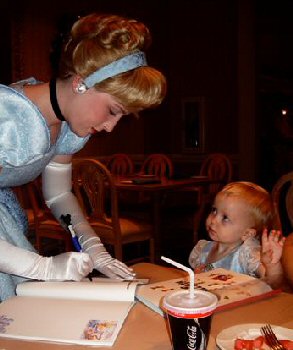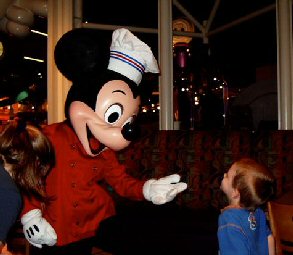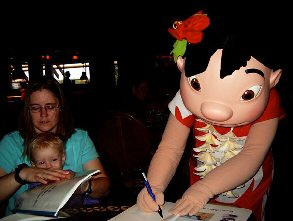By Teresa Pitman
In your dreams, it’s just like the Disney Planning DVD – your three-year-old sees Mickey Mouse (who is miraculously standing all alone), runs to him, and gives him a big, enthusiastic hug while you take photos to record the occasion. Then they play happily for several minutes while you whip out the video camera to save these joyous vacation memories.
In your dreams is right. Here’s what is just as likely to happen. After standing in line for twenty minutes while your older children mutter about how much they’d prefer to be on Splash Mountain, when it’s your turn (at last!), your three-year-old takes one look at Mickey and runs behind your legs crying. Your attempts to coax him to stand near Mickey for just one picture lead to more tears. The Cast Members are looking impatient and the guests lined up behind you are starting to complain out loud.
So how can you make your children’s interactions with the characters the fun and positive experiences you are hoping for?
“Big Scary Mickey”
All kids are different, but many toddlers and preschoolers find the characters pretty scary. They’re big, for one thing. Any adult is big to a small child, but often the character’s head and costume make him or her even taller. The fact that the eyes and mouth on the face don’t move is also scary for many children – they look obviously “fake.” Also, many of the characters use big, expansive gestures to compensate for the fact that they can’t talk, and that can feel aggressive to a little kid.
So what can you do? Prepare your child in advance that he’ll be seeing “Big Mickey” and other characters. Talk about how tall they will be. Let them watch and play with hand-puppets, and tell them that “Big Mickey” will look kind of like a puppet.
If your child is still reluctant, you may find that meetings with the “face” characters – those who don’t have heads covering their faces – may go more smoothly. You can always get the pictures with Mickey and Goofy next time.
Time pressures
Some children are what development experts call “slow to warm up.” They are interested in the characters, but just not ready to run over and give them a hug right away. They need to look things over and prepare themselves – something that isn’t always possible when the parks are crowded and the next family is eager for their photo op.
One way to handle this is to plan for character meals rather than meeting the characters in the parks. This gives your child a chance to watch the characters greeting kids at other tables so that he can prepare for the moment Stitch comes to say hello to him. If you need to line up, try having one parent in the line while the other takes the child off to the side to watch the character and kids interacting. Then when that parent gets to the front, the child can take his turn to have a photo with Chip and Dale.
“Don’t Talk to Strangers!”
That’s what you’ve been teaching your child all along, isn’t it? In fact, whether or not you’ve been deliberately telling your little one this, most young children are naturally cautious around people they don’t know. That includes Peter Pan and Aladdin.
You can help prepare your child for this situation by making sure the characters are familiar to them. Read books, watch DVDs, tell the stories and show them photos so they know the stories about the people and critters they will see. But remember, as mentioned earlier, that a larger-than-life Mickey can seem like quite a different character than the familiar Mickey from TV.
Stand By Me
Children always feel safer in strange situations when they have a parent with them. If your child is still feeling nervous about the characters, she might be willing to pose for a photo if you’re in the photo too – perhaps standing between your child and Stitch, or holding her in your arms. (This way you’ll get more photos of you enjoying your vacation, too!)
The Over-Exuberant Child
The opposite of the child who finds the characters a bit too frightening is the child who sees them as familiar and beloved playmates, and whose excitement at seeing Mickey gets out of hand as he throws himself at the Mouse. These children may also be disappointed that their time with the character is often limited to just a minute or two before the next family takes a turn.
If you see your little one getting very excited, remind him about the need to be gentle with his friends, and consider holding his hand as you approach. Character meals can also be a good choice as they often allow the characters to spend more time visiting with each family, and there’s usually another “friend” on his way when the first one departs.
And One Last Reminder for Parents –
Keep in mind that the costumes often restrict the character’s field of vision quite dramatically. Pooh may not be able to see your three-year-old running towards him, or the toddler about to grab his leg from behind. So stay close and speak up if you need to. This is also a good reason to keep your child in line or in his seat at the table until it is his turn – if she moves in too quickly, Pooh might ignore her not out of unfriendliness but because he simply isn’t aware that she’s trying to get his attention.
The characters are a very special part of WDW, and with a little planning and your knowledge of your child’s individual personality, these interactions can truly be some of the most magical moments you’ll experience.



